University of Chester
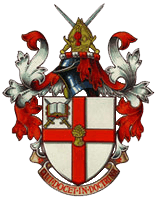 Coat of arms of the University of Chester | |
Former names |
List
|
|---|---|
| Motto | Latin: Qui docet in doctrina |
Motto in English | "He that teacheth, on teaching" |
| Type | Public |
| Established |
2005 – gained University status 1839 – Chester Diocesan Training College |
| Endowment | £2,000,000[1] |
| Budget | £119.2 million[2] |
| Chancellor | Gyles Brandreth |
| Vice-Chancellor | Tim Wheeler |
Academic staff | 870[3] |
Administrative staff | 1220[3] |
| Students | 14,900 |
| Undergraduates | 10,800[4] |
| Postgraduates | 4,100[4] |
| Location |
Chester, Ellesmere Port and Warrington, Cheshire, UK 53°12′01″N 2°53′53″W / 53.200326°N 2.898073°WCoordinates: 53°12′01″N 2°53′53″W / 53.200326°N 2.898073°W |
| Campus | Urban |
| Colours | Burgundy[5] |
| Affiliations | ACU, NWUA, Cathedrals Group |
| Website | www.chester.ac.uk |
 | |
The University of Chester is a public university located in the historic city of Chester, England. The University, the first purpose-built teacher training college in the UK, based in five campus sites in and around Chester and one in Warrington, offers a range of foundation, undergraduate and postgraduate courses, as well as undertaking academic research.
The university is a member of the Association of Commonwealth Universities, the Cathedrals Group, the North West Universities Association and Universities UK.
History
1839 to 2000
The university was founded as Chester Diocesan Training College in 1839 by a distinguished group of local leading figures in the Church of England, including future Prime Ministers William Ewart Gladstone and the 14th Earl of Derby.[6] It was the UK's first purpose-built teacher training college,[7] which makes it one of the longest established higher education institutions in the country.[8] In 1842, Gladstone opened the college's original buildings for its first intake of ten male student teachers on the Parkgate Road site, just outside the City Walls, that the university occupies today.[9]
In 1921, Chester formally became an affiliated college of the University of Liverpool,[6] which meant that the University of Liverpool awarded Chester's qualifications and Chester's students were able to use Liverpool's facilities.
The institution was threatened with closure in the 1930s, but its future was secured by the Bishop of Chester in 1933.[10] From then on, the college continued to grow steadily. By the 1960s, as the UK was massively expanding its higher education capacity in reaction to the Robbins Report, the college was considered as a possible candidate for university status. These proposals, however, were not followed through.
The college continued to expand and women were first admitted in 1961. In 1963, the government renamed teacher training colleges to colleges of education, so Chester's name became Chester College of Education. In 1974, the number of courses was expanded beyond teacher education to include Bachelor of Arts and Bachelor of Science degrees. To reflect its wider remit, the college was renamed Chester College of Higher Education.
In the early 1990s the School of Nursing and Midwifery (now the Faculty of Health and Social Care) was established.[6] The college also began to offer a Bachelor of Theology degree, HNDs and more postgraduate courses, such as master's degrees and PhDs.[6] It also embarked on a £10 million campus improvement programme. By 1996, Chester had earned the right to call itself University College Chester.[11][12] This name, however, was short-lived as the government changed the requirements for university colleges in 1999 to include only those that had their own degree-awarding powers. Thus, Chester had to drop the 'University College' tag and reverted to the title Chester College of Higher Education, though the more descriptive Chester, a College of the University of Liverpool was frequently used in publicity material.[8]
2000 to present
The college expanded in 2002 through the acquisition of the higher education faculty and campus of Warrington Collegiate Institute.[6] (The further and adult education campuses of Warrington remained independent and are now known as Warrington Collegiate.)
In 2003 Chester was granted its own degree-awarding powers, allowing it to be known as University College Chester once again.[8] Due to its long (and well-advertised) association with the University of Liverpool, Chester continued to award Liverpool degrees until the 2005 intake of students.[13]
In 2005, University College Chester was awarded full university status and became the University of Chester.[14] This was followed by the right to award its own research degrees in 2007, ending Chester's last validation arrangement with Liverpool.
Following the 2008 Research Assessment Exercise, some of the university's research was declared to be of international quality, with a proportion of 'World Leading' research in History (15% of submitted research), English, Sports Studies, and Drama (each 5% of submitted research).[15][16][17]
In 2010, the Centre for Work Related Studies (CWRS) received a commendation by the UK quality body, for its radically flexible and high quality negotiated work based learning framework - enabling professionals to customise their own qualifications, 'learn through work', and enable rapid accreditation of commercial training provision. At the same time, the funding body showcased CWRS's flexible approach to accrediting workplace learning.[18][19]
Expansion
The university has expanded in recent years, purchasing derelict and unused buildings in and around the city, renovating and repurposing existing sites for education use. In 2013 the university took over the Shell Technology Centre in Thornton, in nearby Ince, creating the Thornton Science Park[20] which has allowed a host of new engineering-related degree programmes to be offered by the university.
Campuses

The University of Chester has six campuses. The 32-acre (130,000 m2) Parkgate Road Campus, Chester,[14] is located on Parkgate Road, just north of the City Walls. It has a mixture of Victorian buildings (such as Old College, left, which includes a chapel built by some of the original students in the 1840s) and modern buildings (such as the Students' Union). The Parkgate Road Campus also features a fitness centre, sports hall, swimming pool, science and language laboratories, bar, bookshop and bank.
Some departments are housed offsite at locations within walking distance of the main campus, for example, the Department of English is located in a Grade II-listed former Victorian vicarage, while the Law School is based at 67 Liverpool Road.
There are a number of significant additions to the institution's estate. The former County Hall, which is located in the city centre near the racecourse, houses the Faculty of Education and Children's Services and the Faculty of Health and Social Care and is known as the Riverside Campus.
The university has also developed the Kingsway Campus in Newton with the addition of a three-storey teaching block, ground floor exhibition space and art gallery, learning resource centre and changing rooms. The site features a number of green innovations, such as ground source heating.
The university acquired a former Lloyds Bank corporate headquarters in Queen's Park, Handbridge, Chester in 2015. This houses the Faculty of Business and Management and the Chester Business School. The university has invested heavily in upgrading and modernising the facilities in Bridge House and Churchill House to create high quality facilities that can cater for 2,700 students.
In the autumn of 2015, the university opened a sister institution in the Guildhall and Rowley's House, Shrewsbury, Shropshire as part of a joint venture with Shropshire Council to establish University Centre Shrewsbury.
The university-owned student accommodation is primarily reserved for first year and overseas students. This consists of halls of residence and houses nearby.
The smaller Warrington campus originally hosted a camp for Canadian officers in World War II and is located in the Padgate area of Warrington. This campus includes the North West Media Centre, which has close ties to Granada Television, The Warrington School of Management, Social Sciences and Health and Social Care.[21] The Warrington Campus is also the training ground for the rugby league team The Warrington Wolves, and Warrington town was the host for the Rugby League World Cup 2013, with the Campus hosting the Samoan players.
In 2014 Chancellor George Osborne opened the university's new Science Park in Thornton, based at the site previously used by Shell UK for research and development. The Campus is used for a variety of science and engineering based courses and allows students to be involved in high-level research using the Campus's industry-standard facilities gifted by Shell. However, in 2018 the local authority, taking account of guidance from the Health and Safety Executive, refused a retrospective planning application for continued use for educational purposes on safety grounds, due to the location close to Stanlow oil refinery. This is being appealed by the university (https://www.chesterchronicle.co.uk/news/chester-cheshire-news/university-chester-lodges-appeal-salvage-14988094}.
Also in 2014, Dr Loyd Grossman, who holds an honorary degree from the university, officially opened the North West Food Research Development (NoWFOOD) Centre.
The university also has a number of bases at NHS sites across Cheshire and the Wirral.
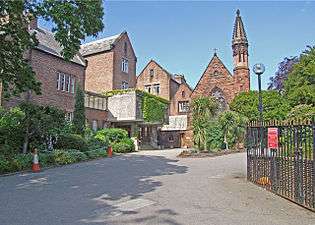 Parkgate Road Campus, Chester
Parkgate Road Campus, Chester- Grosvenor House, Parkgate Road Campus, Chester
 Parkgate Road Campus, Chester Alumni Garden
Parkgate Road Campus, Chester Alumni Garden The Riverside Campus
The Riverside Campus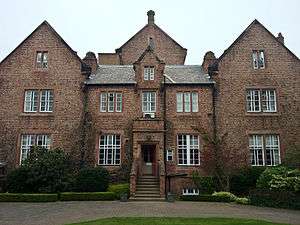 Senate House, Parkgate Road Campus, Chester
Senate House, Parkgate Road Campus, Chester- University of Chester Law School, Liverpool Road
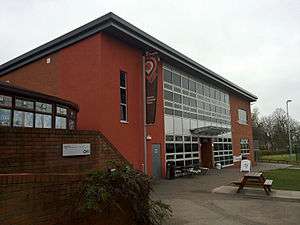 Students' Union building, Parkgate Road Campus, Chester
Students' Union building, Parkgate Road Campus, Chester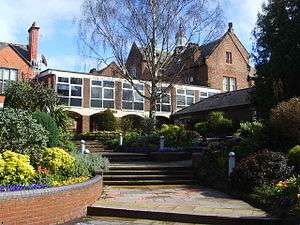 Cloisters, Parkgate Road Campus, Chester
Cloisters, Parkgate Road Campus, Chester- Chester Cathedral, site of the graduation ceremonies
Organisation and structure
The university is organised into seven faculties of study. Several of these are subdivided into academic departments.[22] The faculties and departments are:
- Faculty of Arts and Humanties
- School of Arts and Media
- School of Humanities
- Chester Centre for Research in Arts and Media
- Faculty of Business and Management
- Centre for Work Related Studies
- Corporate Business and Enterprise
- University of Chester Business School
- Professional Development
- Sport and Community Engagement
- Work Based Learning Office
- Warrington School of Management
- Faculty of Education and Children's Services
- Faculty of Health and Social Care
- Faculty of Medicine, Dentistry and Life Sciences
- Biological Sciences
- Clinical Sciences and Nutrition
- Chester Medical School
- Sport and Exercise Sciences
- Centre for Stress Research
- Faculty of Science and Engineering
- Centre for Science Communication
- Computer Science
- Chemical Engineering
- Electronic and Electrical Engineering
- Mathematics
- Mechanical Engineering
- Natural Sciences
- New Technology Initiative (NTI)
- The Informatics Centre
- Faculty of Social Science
- Geography and International Development
- Psychology
- Social and Political Science
- University of Chester Law School
- Institute of Policing
In addition, a number of research centres operate alongside the departments.
From 2015 to 2020 the University of Chester provides validation for PhD programmes offered by Glyndŵr University.
Coat of arms
The university's coat of arms was granted by the College of Arms in 1954. The arms, pictured above, are made up of an argent shield featuring the St George's cross on which there is a golden wheatsheaf, representing the Earldom of Cheshire. In the first quarter of the shield is a clasped open book, symbolising learning. The crest features a mitre, signifying the institution's founding by the Church of England, in front of two crossed swords, which are taken from the County of Cheshire's coat of arms. The golden scroll contains the Latin motto, "qui docet in doctrina", an extract from Saint Paul's epistle to the Romans and translates as "he that teacheth, on teaching" or "let the teacher teach".[23]
The coat of arms was used as the college's logo until the early 1990s when a new logo, with a depiction of the Old College building, was introduced. The coat of arms returned to the college's logo in 2002 when a simplified version became part of the logo. The university's current logo, introduced in 2005, features the shield and scroll from the coat of arms.
From 2015, as part of the 175th-anniversary celebrations, the university's coat of arms includes griffins – one in gold, and one in black – either side to represent Gerald Grosvenor who has served as Founding Chancellor since the institution became a university, and ex-Prime Minister William Gladstone, one of the Founders in 1839.
Academic profile
Most of Chester's 14,900 students are from the UK.[4] A quarter of students are mature and there are twice as many female students as male (partially due to the number of nursing, midwifery and teaching students). The increasing number of foreign students are mainly participants in the university's active exchange policy.
There are approximately 2,090 members of staff, 870 of whom are academic. Many take part in research and often publish their work through the institution's own publishing house, the University of Chester Press. The 2014 Research Assessment Exercise resulted in Chester's research being declared world-leading in 14 areas of that submitted.
Former Archbishop of Canterbury Rowan Williams was, in 2011, bestowed a visiting professorship with the title Gladstone Professor of Literature and Theology. His inaugural lecture 'The Messiah and the novelist: approaches to Jesus in fiction' took place in Chester Cathedral.
Peter Blair and Ashley Chantler edit Flash: The International Short-Short Story Magazine, a major literary periodical, which publishes stories and reviews of up to 360 words by writers from around the world.[24]
Reputation and rankings
Global rankings | ||
| Complete[25] (2019) |
98 | |
|---|---|---|
| The Guardian[26] (2019) |
94 | |
| Times / Sunday Times[27] (2019) |
61= | |
British Government assessment | ||
| Teaching Excellence Framework[28] | Silver | |
The Quality Assurance Agency for Higher Education (QAA) 2010 audit praised the university for its good practice in ensuring standards and enhancing the quality of learning opportunities, the supportive relationships that underpin the learning and working in the institution and the strength of its partnership work.[29]
The Faculty of Education and Children's Services also celebrated an 'outstanding' outcome in its recent Ofsted inspection of Initial Teacher Training.[30]
The university was ranked 69th in The Guardian 2016 University Guide and 67th in The Times and Sunday Times University League Table 2015.
Student life
Chester Students' Union (CSU) offers services and provides facilities for students and is a member of the NUS. Four sabbatical officers are elected each year and serve a maximum of two years.
The Executive Committee are the trustees of the Union. Members are elected each year before the end of March, with a president and vice-president, and each with a different role, such as Education representative, Activities representative and a Warrington representative. The support staff for the Union consists of a number of full-time employees, part-time student staff and volunteers from the elected Executive Committee and the Union Council.
The Union runs a bar 'CH1' on the main Parkgate Road Campus, Chester. The previously known 'Padgate Union Bar' on the Warrington campus was, in August 2010, taken over by the university, and is now known as 'Bar and Club 2010'. The Union also has three shops. Two are on the Parkgate Road Campus, Chester, consisting of a general shop and a Starbucks Coffee franchise, and one at Warrington.
The Union also runs over 110 sports clubs and societies; with each campus having its own teams, many of which compete in British Universities and Colleges Sport competitions. Once a year, the Union runs an inter-campus competition known as Varsity on campus where sporting societies, such as seven-a-side football, and non-sporting societies, such as poker, compete. Non-sporting societies include the Debating Society (which has hosted hustings events which have featured on 'BBC North West Tonight'), the Politics Forum, the Drama Society, the Amnesty International Society, the International Development Society and the People and Planet Society. A student radio station, The Cat Radio, is based on the Warrington campus and broadcasts daily, with presenters on air from September until July.
University of Chester Academies Trust
The University of Chester is the sponsor for a number of academies and free schools in Cheshire and Merseyside. The university provides its sponsorship through the University of Chester Academies Trust.[31] Schools within the trust include:
- University Academy Kidsgrove
- University Academy Warrington
- University Cathedral Free School
- University of Chester Church of England Academy, Ellesmere Port
- University of Chester Academy Northwich
- University Primary Academy Kidsgrove
- University Primary Academy Weaverham
- Ormiston Bolingbroke Academy, Runcorn (in conjunction with the Ormiston Trust)
Notable people

Chancellors
- 2005–2016: Major General Gerald Grosvenor, 6th Duke of Westminster, KG CB CVO OBE TD DL CD[6]
- 2016 to date: Dr Gyles Brandreth
Vice-chancellor/ Principals
Note that until university status was awarded in 2005, the Vice-Chancellor was known as the principal.
- 1839–1869: Arthur Rigg[6]
- 1869–1886: J. M. Chritchley[6]
- 1886–1890: A. J. C. Allen[6]
- 1890–1910: John Best[6]
- 1910–1935: Richard Thomas[6]
- 1935–1953: Stanley Astbury[6]
- 1953–1965: Aubrey Price[6]
- 1966–1971: Bernard de Bunsen[6]
- 1971–1987: Malcolm Seaborne[6]
- 1987–1998: Ned Binks[6]
- 1998–present: Tim Wheeler[6] (Vice-Chancellor and Principal)
Staff
- Stewart Ainsworth archaeologist (Department of History and Archaeology, 2010–present)
- Sir William Crookes, chemist (1855-unknown)[32]
- Elaine Graham, theologian (Department of Theology and Religious Studies, 2009–present)
- Ron Geaves, theologian (Department of Theology and Religious Studies, 2001–2007)
- Anthony Thiselton, theologian (Department of Theology and Religious Studies, 2001–2006)[33]
- Gordon Turnbull, psychiatrist (Centre for Research and Education in Psychological Trauma)
- Alan Wall, novelist (Department of English, 2004–present)
- Howard Williams, archaeologist (Department of History and Archaeology, 2008–present)
Alumni
- Alan Bleasdale, screenwriter (Cert Ed, 1964–1967)
- Jim Bowen, Bullseye presenter (Cert Ed Physical Education, 1957–1959)[34]
- Sir Dave Brailsford CBE, Performance Director of British Cycling and General Manager of Team Sky, (BSc (Hons), Sports Science and Psychology, 1987–1990) )
- Michael Campbell, drummer in The Courteeners (BA(Hons) Television Production, 2002–2005)[35]
- John Carleton, international rugby union player
- Jon Clarke, international rugby league player (BSc(Hons) Sport and Exercise Sciences, 2006–2010)[16]
- George Courtney MBE, international football referee (Cert Ed Geography, 1959–1961)[35]
- Duffy, singer (BA(Hons) Popular Music, Drama and Theatre Studies, 2004–2006; dropped out)[36]
- Alan Emery, (teacher training, 1945–1947), the first to delineate the disease Emery–Dreifuss muscular dystrophy; its protein, Emerin, was named after him, as was the Emery-Nelson syndrome[37]
- Jo Fletcher, international footballer (MSc Exercise and Nutrition Science, 2003–2005)[38]
- Matt Greenhalgh, film director and screenwriter (BA(Hons) Media Studies with Business Management and Information Technology, 1992–1995)[35]
- Dick Howard, international footballer (HND Physical Education, 1963–1965)[39]
- Roderick Hunt MBE, children's author (Cert Ed Divinity and English, 1957–1959)[38]
- Helen Jones MP, politician (PGCE)[39]
- Eddie Lever, footballer and manager (Cert Ed, 1931–1933)[40]
- J. Thomas Looney devised the Oxfordian theory (Cert Ed, 1890–1891)[41]
- Tracey Neville, international netball player (BSc(Hons) Nutrition and Exercise Science, 2004–2007)[16]
- Jon Sleightholme, international rugby union player (1991–1994)[41]
- David 'Comedy Dave' Vitty, radio presenter (BA(Hons) Media Studies and Business Management, 1992–1995)[35]
- Nicola Wilson (née Tweddle), British athlete specialising in three-day eventing, degree in Sport and Business Management at the Warrington Campus, graduated in 1999[42]
- Sir Walter Winterbottom, footballer and first manager of the England football team (Cert Ed, 1931–1933)[40]
- Rob Wotton, television and radio presenter (BA(Hons) Health and Community Studies, 1987–1990; Union President, 1990–1991)[39][43]
References
- ↑ "2013 Annual Review". Archived from the original on 6 October 2014. Retrieved 3 October 2014.
- ↑ "2016 Annual Review" (PDF).
- 1 2 "Chester 2010/11". Higher Education Statistics Agency. Archived from the original (webpage) on 13 September 2015. Retrieved 19 July 2012.
- 1 2 3 "2016/17 Students by HE provider, level, mode and domicile" (CSV). Higher Education Statistics Agency. Retrieved 25 March 2018.
- ↑ "Archived copy" (PDF). Archived from the original (PDF) on 10 August 2011. Retrieved 7 May 2008.
- 1 2 3 4 5 6 7 8 9 10 11 12 13 14 15 16 17 Ian Dunn, The University of Chester, 1839–2008: The Bright Star in the Present Prospect, 2nd edn (Chester: Chester Academic Press, 2008)
- ↑ University of Chester: News and Events
- 1 2 3 University of Chester: News and Events
- ↑ "Statuette of W. E. Gladstone". Chester.gov.uk. Archived from the original on 19 October 2007. Retrieved 29 November 2011.
- ↑ "Twentieth century Chester 1914-2000 - The economy, 1918–39 | British History Online". British-history.ac.uk. Retrieved 29 November 2011.
- ↑ "Principal's Foreword/University College Chester". Archived from the original on 24 February 1998. Retrieved 16 July 2015.
- ↑ https://www.qaa.ac.uk/reviews/reports/institutional/heqc/ChesterCollegeHE_QAG513.asp%5Bpermanent+dead+link%5D
- ↑ "Reviews and reports". Archived from the original on 22 October 2011. Retrieved 16 July 2015.
- 1 2 "Chester, University of". The Independent. London. 22 June 2009. Retrieved 27 May 2010.
- ↑ "RAE 2008 : Quality profiles". Retrieved 16 July 2015.
- 1 2 3 The Cestrian, 2008
- ↑ University of Chester Annual Review 2009
- ↑ "Report on the University of Chester". Archived from the original on 28 June 2012. Retrieved 27 March 2012.
- ↑ "HEFCE report".
- ↑ "- MP hails University of Chester's planned expansion". Chester First. Archived from the original on 30 March 2014. Retrieved 16 July 2015.
- ↑ Elsie Newton, The Padgate Story, 1946–2006; University of Chester Annual Review 2009
- ↑ "University of Chester: Faculties". Chester.ac.uk.
- ↑ Martin Goldstraw (5 July 1954). "A Cheshire Armorial - The Arms of The University of Chester". Cheshire-heraldry.org.uk. Retrieved 29 November 2011.
- ↑ ""Flash Fiction Magazine" Accessed 18th September 2009". Chester.ac.uk. Retrieved 29 November 2011.
- ↑ "University League Table 2019". The Complete University Guide. Retrieved 26 April 2018.
- ↑ "University league tables 2019". The Guardian. 29 May 2018. Retrieved 29 May 2018.
- ↑ "The Times and Sunday Times University Good University Guide 2019". Times Newspapers. Retrieved 23 September 2018.
- ↑ "Teaching Excellence Framework outcomes". Higher Education Funding Council for England. Retrieved 11 June 2018.
- ↑ Archived 28 November 2010 at the Wayback Machine.
- ↑ "Find an inspection report" (PDF). Ofsted. 16 December 2010. Retrieved 29 November 2011.
- ↑ "University of Chester Academies Trust - Home". Retrieved 16 July 2015.
- ↑ "William Crookes". Chem.ox.ac.uk. Archived from the original on 25 November 2011. Retrieved 29 November 2011.
- ↑ "Ceremony One: Professor Anthony Thiselton". Retrieved 16 July 2015.
- ↑ Jim Bowen, From a Bundle of Rags: The Autobiography of Jim Bowen (London: Robson Books, 1992)
- 1 2 3 4 "Student News, Summer 2008 - Chester Chronicle". Issuu.com. Retrieved 29 November 2011.
- ↑ "Voice from heaven, family from hell ... The dangerous world that singer Duffy left behind – Mail Online". Daily Mail. London.
- ↑ Green Templeton Manager. "Alan Emery". Retrieved 16 July 2015.
- 1 2 "Archived copy". Archived from the original on 8 July 2011. Retrieved 1 April 2008.
- 1 2 3 "Alumni - Alumni Stories". Chesteralumni.com. Archived from the original on 1 January 2012. Retrieved 29 November 2011.
- 1 2 Glanville, Brian (18 February 2002). "Sir Walter Winterbottom". The Guardian. London. Retrieved 27 May 2010.
- 1 2 The Cestrian, 2009
- ↑ "Nicola-Wilson-Team-GB". The Telegraph.
- ↑ The Collegian, 1999
Further reading
- White, Graeme J, On Chester On: A History of Chester College and the University of Chester (Chester: University of Chester Press, 2014) ISBN 978-1-908258-19-9
- Dunn, Ian, The University of Chester, 1839–2008: The Bright Star in the Present Prospect 3rd edn (Chester: University of Chester Press, 2012)
- Burek, Cynthia and Stilwell, Richard, Geodiversity Trail: Walking Through the Past on the University's Chester Campus (Chester: Chester Academic Press, 2007)
- Newton, Elsie, The Padgate Story 1946–2006 (Chester: Chester Academic Press, 2007)
- White, Graeme J (ed.), Perspectives of Chester College: 150th Anniversary Essays, 1839–1989 (Chester: Chester College, 1989)
- Bradbury, John Lewis, Chester College and the Training of Teachers, 1839–1975 (Chester: Chester College, 1975)
- Astbury, Stanley, A History of Chester Diocesan Training College (Chester: Chester College, 1946)
- Annual Review, www.chester.ac.uk/annual-review
External links
| Wikimedia Commons has media related to University of Chester. |